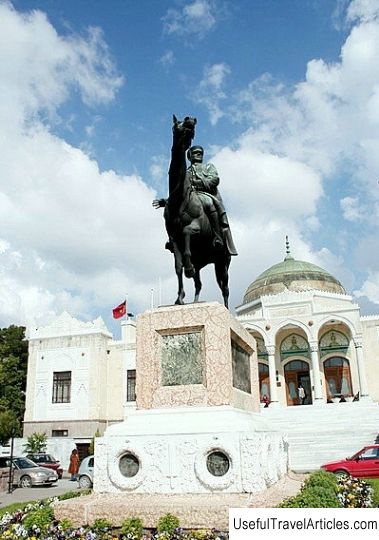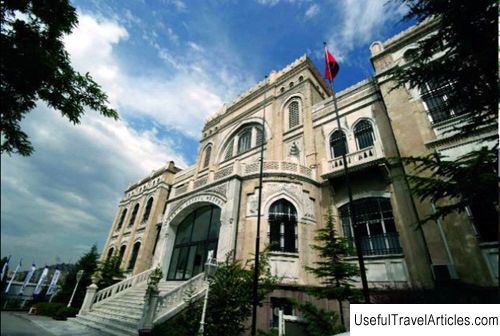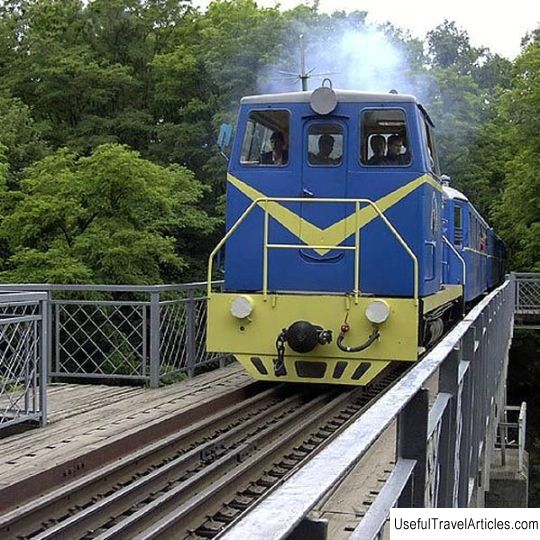Ethnographic Museum (Ankara Etnografya Muzesi) description and photos - Turkey: Ankara
Rating: 9,3/10 (867 votes) 
Ethnographic Museum (Ankara Etnografya Muzesi) description and photos - Turkey: Ankara. Detailed information about the attraction. Description, photographs and a map showing the nearest significant objects. The title in English is Ankara Etnografya Muzesi. Photo and descriptionOver nine centuries of history in the vicinity of Ankara and the city itself, a sufficient number of priceless artifacts have accumulated, which are presented in the excellent collection of exhibits of the Ethnographic Museum. The museum building is easily recognizable by the white marble walls and the statue at the entrance, which depicts Ataturk riding a horse, as the people call the founder of the Turkish Republic Mustafa Kemal. The Ethnographic Museum of Ankara contains collections that characterize the culture and life of the population: Muslim carpets, national clothes, various fabrics, folk musical instruments, textiles and faience products. Here, even the museum building itself is considered a separate and very valuable exhibit. The building is located on the Namazga hill, on the territory of a Muslim cemetery. In order to open the museum, this hill was donated, on the basis of a decree of the Cabinet of Ministers of Turkey, to the Ministry of National Education, in November 1925. The Ethnographic Museum was built by the architect A. Kh. Koyunoglu, who is one of the most famous architects of the early republican period. To collect and purchase artifacts for the museum, a special commission was created in Istanbul, headed by Professor Selal Esada in 1924 and the head of the Istanbul Museums, Halil Ethemom in 1925. The selection of exhibits was completed only in 1927, then there were already more than a thousand of them. In the same year, the director of the museum was appointed. But the grand opening of the Museum of Ethnography took place only on July 18, 1930, on the occasion of the arrival of the Afghan king. Two years earlier, the head of the Turkish Republic Mustafa Kemal visited the museum. In November 1938, the courtyard of the Ethnographic Museum turned into a temporary mausoleum of the Turkish reformer, whose body was here until 1953, when the construction of the Ataturk Mausoleum was completed. Currently, this part of the museum contains a slab of white marble, which shows the date of death of the father of the Turks and the period when his body was in the museum. The Ethnographic Museum has served as a mausoleum for 15 years. Official delegations of various countries have paid visits here. During this time, it was visited by presidents, ambassadors, foreign delegations, as well as ordinary citizens. In the period between 1953 and 1956, the building was renovated and restored, the museum collection was being prepared for the International Museum Week, which took place from 6 to 14 November 1956. The building has a rectangular shape, and its roof is decorated with one dome. The stone walls of the museum are covered with rough sandstone and marble, and the facing pediment has carved decorations. A staircase of twenty-eight steps adjoins the museum. The entrance to the building consists of three parts, separated by four columns with arches. The main entrance leads into a domed hall and a colonnaded courtyard. Originally there was a marble pool in the center of the courtyard and the roof of the building was open. However, after using the museum as a temporary mausoleum for Ataturk, the roof was covered and the pool had to be moved to a garden. The large and small halls of the building surround the courtyard symmetrically. The two-storey administrative complex is located next to the museum. At the request of the Ministry of Public Education in 1927, the Italian artist made a bronze statue of Mustafa Kemal, which now stands in front of the museum. The exposition of the Ethnographic Museum is a collection of examples of Turkish art from the Seljuk period to the present. To the right of the entrance to the museum is a hall dedicated to Anatolian wedding ceremonies, which displays wedding dresses from various cities of Anatolia and a variety of wedding attributes. In the next room you can get acquainted with the patterns and methods of the famous Turkish embroidery. Further, there is a department that introduces the visitors of the Ethnographic Museum to the craft of hand-weaving Turkish carpets and rugs. By visiting the next room, you can get acquainted with the Anatolian culture of coffee making. The museum also has a section dedicated to the solemn ceremony of circumcision. To the left of the entrance is a section of Turkish tiles and glassware, faience and ceramics. Next is the hall, the exhibits of which were donated by Besim Atalay. Other departments introduce visitors to the art of Ottoman calligraphy, the finest wooden artifacts from the Seljuk and princely times.       We also recommend reading Kurgan Regional Art Museum description and photos - Russia - Ural: Kurgan Topic: Ethnographic Museum (Ankara Etnografya Muzesi) description and photos - Turkey: Ankara. |




